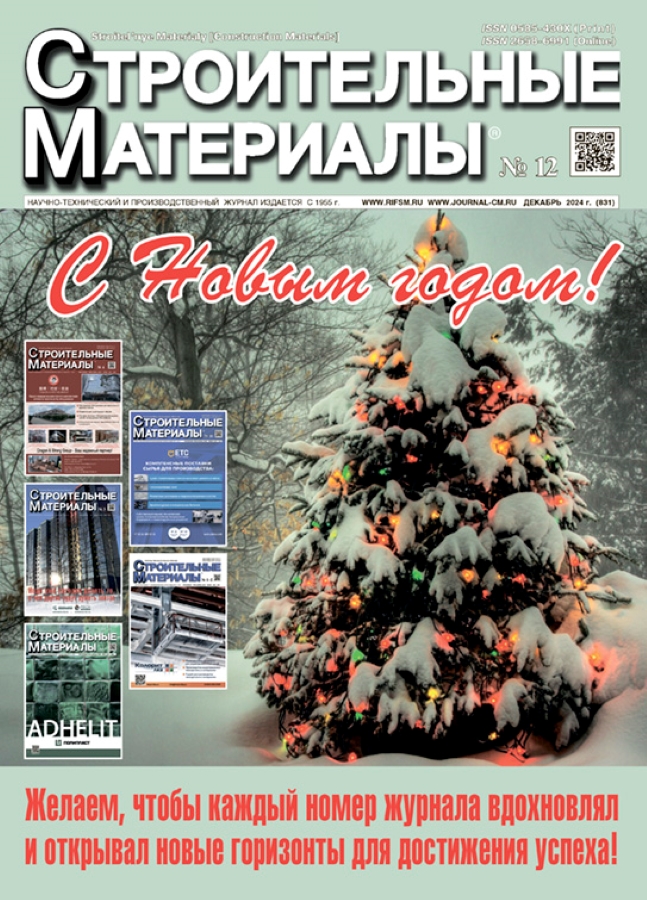Разработка состава комплексной вспучивающей добавки для производства керамзита
- Авторы: Чумаченко Н.Г.1
-
Учреждения:
- Самарский государственный технический университет
- Выпуск: № 12 (2024)
- Страницы: 73-77
- Раздел: Статьи
- URL: https://archivog.com/0585-430X/article/view/646350
- DOI: https://doi.org/10.31659/0585-430X-2024-831-12-73-77
- ID: 646350
Цитировать
Полный текст
Аннотация
Проведена стандартная оценка глинистого сырья Нефтегорского месторождения Самарской области. Установлено, что глина по всем показателям, кроме содержания СаО, соответствует требованиям ГОСТа к сырью для производства керамзитового гравия. Определена группа глинистого сырья как слабо вспучивающаяся глина. Исследовано влияние температуры обжига, содержания органических и железосодержащих добавок на степень вспучивания. Проведена нестандартная оценка глины расчетным методом по химическому составу. Теоретически обоснованы виды и количество необходимых добавок для направленной корректировки состава с целью получения максимального вспучивания. Разработан состав комплексной добавки для повышения вспучиваемости глинистого сырья Нефтегорского месторождения, включающий опоку, пиритные огарки, шлам щелочного травления алюминия и соляровое масло.
Полный текст
Об авторах
Н. Г. Чумаченко
Самарский государственный технический университет
Автор, ответственный за переписку.
Email: psmik@samgtu.ru
д-р техн. наук
Россия, 443001, г. Самара, ул. Молодогвардейская, 244Список литературы
- Горин В.М. Керамзит и керамзитобетон в стройкомплексе страны // Строительные материалы. 2022. № 5. С. 15–18. EDN: VSEQBA. https://doi.org/10.31659/0585-430X-2022-802-5-15-18
- Кабанова М.К., Токарева С.А., Уваров П.П. Основные критерии – безопасность, экологичность и долговечность строительных материалов // Строительные материалы. 2017. № 1–2. С. 90–93. EDN: XXIHVH. https://doi.org/10.31659/0585-430X-2017-745-1-2-90-93
- Саммасов Р.Ф., Панченко Ю.Ф. ООО «Винзилинский завод керамзитового гравия» (Тюменская область). Строительные материалы и изделия из керамзита и керамзитобетона для гражданского и промышленного строительства от фундамента до крыши // Строительные материалы. 2022. № 5. С. 19–21. EDN: NYCGJU. https:// doi.org/10.31659/0585-430X-2022-802-5-19-21
- Чумаченко Н.Г., Горин В.М., Тюрников В.В., Упорова М.Г. Перспективы производства керамзитового гравия в Самарской области // Строительные материалы. 2022. № 5. С. 34–39. EDN: OGAQVV. https://doi.org/10.31659/0585-430X-2022-802-5-34-39
- Колесников Е.А., Волчек Л.Л. Влияние химического состава на вспучиваемость глин. Техн. информ. ВНИИЭСМ. Сер. Промышленность керамических стеновых материалов и пористых заполнителей. М., 1971. Вып. 3. С. 21–23.
- Чумаченко Н.Г. Влияние состава расплава и нерастворившегося остатка на свойства керамзитового гравия // Строительные материалы. 2013. № 1. С. 56–60. EDN: RDOITX
- Чумаченко Н.Г. Возможности программного комплекса для оценки минерального алюмосиликатного сырья // Вестник Приволжского территориального отделения Российской академии архитектуры и строительных наук. Сб. науч. тр. НГАСУ. 2017. Вып. 20. С. 207–212.
- Соколов Л., Фоменко А. Использование отходов в производстве керамзита // Экология и промышленность России. 2015. № 19 (9). С. 30–34. EDN: UGKFUN. https://doi.org/10.18412/1816-0395-2015-9-30-34
- Василенко Т.А., Ламакина М.П. Физико-механические свойства керамзитового гравия, полученного с использованием электросталеплавильного шлака // Вестник БГТУ им. В.Г. Шухова. 2016. № 6. С. 187–196. EDN: VWZDQR
- Левицкий И.А., Павлюкевич Ю.Г., Богдан Е.О., Кичкайло О.В. Производство керамического гравия с использованием гальванических осадков сточных вод // Стекло и керамика. 2013. № 7. С. 23–27. EDN: RNIIAD
- Лемешев В.Г., Петров С.В., Лемешев О.В. Утилизация техногенных продуктов в производстве керамических строительных материалов // Стекло и керамика. 2001. Т. 74. № 3. С. 17–20. EDN: MPJBZH
- Токарева С.А., Кабанова М.К. Утилизация крупнотоннажных отходов. Переработка, обезвреживание и получение полезной продукции // Строительные материалы. 2022. № 5. С. 25–29. EDN: VBRHKP. https://doi.org/10.31659/0585-430X-2022-802-5-25-29
- Гурьева В.А., Дорошин А.В., Вдовин К.М., Андреева Ю.Е. Пористая керамика на основе легкоплавких глин и шламов // Строительные материалы. 2017. № 4. С. 32–36. EDN: YNESCX https://doi.org/10.31659/0585-430X-2017-747-4-32-36
- Косарев А.С., Смолий В.А., Яценко Е.А., Ирха В.А. Ресурсосбережение в производстве искусственного пористого заполнителя для легких бетонов // Стекло и керамика. 2020. Т. 93. № 7. С. 33–38. EDN: JXAHXE
Дополнительные файлы





















